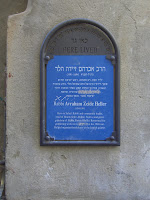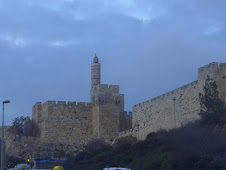
Safed was the first city where the expelled Jews from Spain came and settled. This city became the center of Jewish learning. And, for “the next 80 years, the vibrant Jewish community of Safed formulated mystical philosophies, composed liturgies, and instituted religious customs that are an important part of Jewish life to this day”. Just to mention a few, we have: Rabbi Israel Nagara, who wrote the song Yah Ribbon ha-Olam, Yosef Caro, who wrote the Shulchan Aruch (Prepared Table), the codification of Jewish law; Shlomo Alkabetz, the composer of the song Lecha Dodi (Jewish liturgical song recited on Friday night, usually at sundown, in every synagogue in the world), and Rabbi Shimon Bar Yochai, author of the Zohar (“The Brightness”).
I always thought that the best place to spend Shabbat in Israel is Jerusalem; there is no place like Her where anybody can spend the rest day. But, after being in Tzfat this past Shabbat, I realized that there is another city in Israel where celebrating Shabbat is likewise truly marvelous – indeed, words cannot express such a great experience.
We arrived Friday around 2 PM, after 4 hours of a bus ride from Jerusalem. The scene gently touched my heart, and my eyes were rinsed with a few tears caressing my cheek. The fields of sunflowers and olive tree companions line the road to Safed.
All the stores were closed, with their proprietors preparing to welcome the Queen: the Shabbat.
We stayed in The Central Hotel, one of little hotels of the Old City of Tzfat. What we did not know, was that Meir Meiv, one of the very active members of Etzel had also once stayed there. Etzel [אצ"ל] (acronym for "Irgun Tzva'i Leumi" [ארגון צבאי לאומי] was a military organization for the defense of Jewish people during the British domination in the Holyland.



Across the street, we saw another hotel “Herzlia Hotel” (known also at that time as Perel House), where, during the same era, 1944, other members of Etzel also had stayed under the supervision of Menachem Begin.


We left our belongings in the room, had a little lunch, and then walked a little around the town. Two hours before Shabat, we came back to the room and got ready for Shabbat. It was around 7:10 PM when we went down to the lobby, and, there, candles to be lit in honor of Shabbat. I lighted two candles to welcome the Queen of Shabbat, and then Shabbat started for me. After this, we, my husband and I, walked in the direction of a synagogue. The streets were wafting with the smell of Shabat. People from place throughout Israel and from all over the world were walking through the backstreets of Safed to find a synagogue that would accommodate each and all of us. There are “tons” for this little city!
We saw a map that includes all the Synagogues, and their location...

צפת has two Ha'Ari Synagogues: one known as the Ashkenaz Ha'Ari Synagogue, and the second one the Sephardic Ha'Ari Synagogue. Both of them are named for Rabbi Yitzhak Luria, an important Kabbalist. On the narrow streets, everybody was there: Rabbis, and congregations. The men were with the Rabbis, the women stayed a little behind.
Everybody was singing, the weather was great, not hot at all, the mountains surrounded us, the stars illuminated our book's pages, so that we were reading with no problem.




It was a great experience -- no words, I realize, could describe my feelings about it. After the first part of the singing, the people went to which ever synagogue they chose. We just stayed where we were and then came back to the hotel.
While we were walking back to the hotel, I remembered a Talmudic legend about two angels (one bad and one good) who accompany each Jew home from the synagogue. That night, I truly felt them. We arrived at the hotel and went to the dining room where the tables where set in honor of Shabbat. After eating and singing, we went to sleep and rested from the long day.
Early, the next day, we awoke, went to the dining room, ate a piece of cake and drank something cold -- then went to the synagogue. This time we choose the Beirav Synagogue. The Beirav Synagogue is named for the famous 16th century Torah sage, Rabbi Jacob Beirav, a native of Spain and student of the Ari HaKadosh, and the teacher of Rabbi Yosef Caro, who codified Jewish law in the Shulchan Aruch. The Beirav Synagogue is located on #10 Meginei Tzfat Street, (I will dedicate a space for the meaning of the street name, later in this blog), a modest building more than a century old, The special nature of the service here is the style they follow: the style of the tunes of Rabbi Shlomo Carlebach, which are especially touching and inspiring.



We continue celebrating Shabbat, as we usually do.
In the late afternoon, before Shabbat ended, we went and walked on the other side of Tzfat. While we were walking, we saw a few little synagogues: we were looking for the Rabbi Yosef Karo Synagogue. Asking the residents, they told us that it is a very little synagogue – but, to tell you the truth, we were not expecting that it was so little. But, here we are, right in front of this diminutive synagogue! We cannot go in because it was closed, but it was nice to see it from outside.



We also saw the following synagogues: Abuhav, Trisk, Tzemach-Tzedek, Chortkov, and others whose names I do not remember.Here are some more pictures of...
The Abuhav synagogue


This wall is all that survives from the synagogue named Lemberg.

On Sunday morning, we went to the Square Meginim in the Old City, and continued walking forward to the top of the Main Street of the city.

We came upon the Davidka Monument. Here you find also information posted on the memorial stone, and there is an audio information post, as well, which tells the story of the battle for Safed in both Hebrew and English.



Meginei Tsfat (Tzfat defenders)year 1948, symbol

This place, as every corner in the city, is full of history: her stones do not talk, but you can read in each one of them what happened at this specific point, who fell in that corner, and so on...



Some walls of this side of the city, still remember the bullets recieved in 1948.



And, if you need more explanation, there is always someone who can tell you more or answer your questions.
Also, that Sunday, we went to see the history written on some façades of the houses in Safed. In a few of them, you read : “Here lived…”, “Here fell…”: “Here lived Moisés Pedatzsur (…) he demanded the inclusion of Safed in the Jewish part of the partition plan…”.

In other plaque, we read “Here lived Rabbi Abraham Zeide Heller (…) Helped organized the defense of the Jewish Quarter”.

“Here lived Yitzhak Moshe Zilber (…) Ransomed Jewish prisoners held in Turkish jails and later illegal immigrants during British Mandate, (…)” .“In this house fell Gideon Ilon, age 21 (…)”, “In this house fell Yehoshua Prag’Ochana, age 18”(...). “Here fell Alrer Moshe, 23 years old”, “Here fell Abraham Shakror, age 42”.


Here in Safed we found a "Solar Oven"

Also we saw some electrical boxes very nicely decorated. This is something very common in Israel.


While you walk around Tzfat, you can hear echoing voices of the young soldiers from Etzel or Palmach [Strike Companies], who were fighting to defend the Jewish people from the enemy. Their echoing voices telling us that we, as Jewish individuals, can walk without fear and repeat their story to our children and grandchildren.
Safed’s streets are clean of dust . . . but rich in history and feelings.


me gusta tu blog,felicitaciones; te recomiendo el mio en caso que quieras más información acerca de la gastronomía peruana... un gusto de conocerte
ReplyDeleteMuchas gracias!
Delete